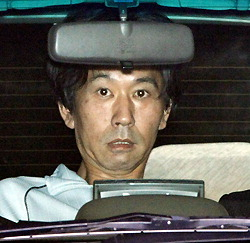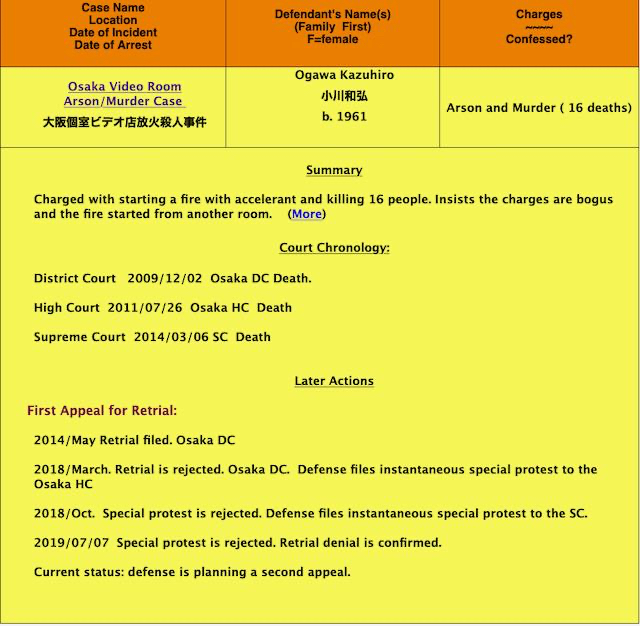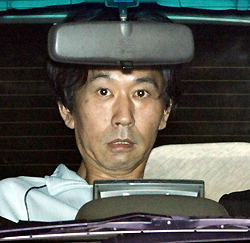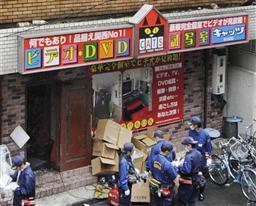OGAWA Kazuhiro
On death row in Osaka
~~~~~~~~~~~~~~~~~~

Kazuhiro Ogawa is pictured in this October 2008 file photo. (Mainichi)
Case Chronology

2011/07/26
OSAKA -- A high court upheld a lower court ruling that handed the death penalty to a man over a fatal arson attack at an adult video shop.
Kazuhiro Ogawa, 49, was sentenced to death by the Osaka High Court on July 26 for setting fire to a video shop in Osaka's Naniwa Ward and leaving 16 people dead in October 2008. The court upheld an earlier ruling by the Osaka District Court that convicted him of arson of an inhabited structure and murder.
"It was a catastrophic incident that has rarely been seen in Japanese criminal history, and it is only natural for the bereaved families of the victims to call for the ultimate penalty. The defendant deserves the maximum sentence," said Presiding Judge Sumio Matoba.
Ogawa's defense counsel is set to appeal the ruling. They have maintained his innocence, claiming that the fire did not start from a room where he was in and that he did not set the facility on fire.
Presiding Judge Matoba dismissed their claims, arguing that the fire started in Ogawa's room on the grounds of the traces of flames and the extent of fire damage to the walls. The presiding judge also rejected the possibility of an accidental fire, turning down the lawyers' assertion that there was a factual error in the lower court ruling. He cited testimonies where the defendant said he was sorry and that he would compensate for the damage soon after the incident outside the video shop.
The presiding judge also determined that the defendant's confessions to the crime during the investigations were "no doubt" arbitrary, adding that the lower court decision that recognized the defendant's willfulness was reasonable.
The presiding judge determined the sentence in view of the gravity of the incident. He concluded that there was "no choice but to deliver the ultimate penalty," citing the fact that the defendant turned around to deny the allegations toward the end of the investigation and categorically denied committing arson during the trial.
~~~~~~~~~~~~~~~~
個室ビデオ殺人:控訴棄却し2審も死刑 大阪高裁
2011年7月26日 20時18分 更新:7月26日 22時44分
大阪市浪速区の個室ビデオ店に放火して16人を殺害したなどとして、現住建造物等放火と殺人などの罪に問われ、1審で死刑判決を受けた無職の小川和弘被告(49)の控訴審判決が26日、大阪高裁であった。的場純男裁判長は「犯罪史上まれにみる大惨事で、多くの遺族が極刑を望むのは当然。最大限の非難に値する」として、1審判決を支持し、弁護側控訴を棄却した。弁護側は上告する方針。
事件は08年10月に発生し、1審の大阪地裁は求刑通り、死刑を言い渡した。弁護側は、出火場所は被告の個室ではない▽放火しておらず、1審は事実誤認--などと無罪を主張していた。
弁護側の主張に対し、的場裁判長は、炎が流れた形跡や壁面などの焼損状況から、出火場所は被告の部屋と認めた。また、失火の可能性がなく、被告が店の外で「すいません」「補償します」と述べたという証言を踏まえ、「放火は事実誤認」との主張を退けた。捜査段階で被告が話した自白の任意性も「疑いはない」と判断した。
こうした点から「室内に可燃性が高い物があり、火を放てば建物を焼損させ、他の客が死亡する危険があることを認識していた」と被告の故意を認めた1審の判断は相当、と指摘した。
量刑を争う控訴審ではなかったが、的場裁判長は事件の重大性を考慮し、職権で量刑を検討した。被告が捜査段階の終盤で否認に転じて公判で放火を全面否定したことなどを挙げ、「極刑をもって臨むほかない」と結論付けた。
判決などによると、小川被告は08年10月1日未明、「キャッツなんば店」の個室で自殺しようと考え、ティッシュペーパーにライターで火を付けて店を全焼させ、客16人を急性一酸化炭素中毒などで死亡させ、4人に重軽傷を負わせた。【久保聡、苅田伸宏】
~~~~~~~~~~~~~~~~~~~~~~~~~
大阪・難波の個室ビデオ放火殺人、二審も死刑
大阪・難波で2008年10月に起きた個室ビデオ店放火殺人事件で、殺人などの罪に問われた無職小川和弘被告(49)の控訴審判決が26日午後、大阪高裁であった。的場純男裁判長は求刑通り死刑とした一審・大阪地裁判決を支持し、被告側の控訴を棄却した。
09年12月の一審判決によると、小川被告は08年10月1日未明、知人と一緒に入った個室ビデオ店で人生に嫌気がさして自殺を考え、かばんの荷物などに放火。店を全焼させ、客16人を殺害、4人を負傷させた。被告は裁判員制度導入前の同月に起訴された。
小川被告は逮捕時に放火と殺意を認めたが、起訴直前に一転して否認。一審の公判で弁護側は「捜査員から強く迫られて虚偽の自白をした。火元は被告のいた18号室ではなく、燃焼が最も激しい9号室だった」と無罪を主張した。これに対し、一審判決は店員の「18号室のかばんから火が出ていた」とする目撃証言などから小川被告による放火行為を認定。「逮捕前の任意聴取の時点で犯行を認めており、自白も信用できる」と判断した。
個室ビデオ殺人:控訴棄却し2審も死刑 大阪高裁
2011年7月26日 20時18分 更新:7月26日 22時44分
大阪市浪速区の個室ビデオ店に放火して16人を殺害したなどとして、現住建造物等放火と殺人などの罪に問われ、1審で死刑判決を受けた無職の小川和弘被告(49)の控訴審判決が26日、大阪高裁であった。的場純男裁判長は「犯罪史上まれにみる大惨事で、多くの遺族が極刑を望むのは当然。最大限の非難に値する」として、1審判決を支持し、弁護側控訴を棄却した。弁護側は上告する方針。
事件は08年10月に発生し、1審の大阪地裁は求刑通り、死刑を言い渡した。弁護側は、出火場所は被告の個室ではない▽放火しておらず、1審は事実誤認--などと無罪を主張していた。
弁護側の主張に対し、的場裁判長は、炎が流れた形跡や壁面などの焼損状況から、出火場所は被告の部屋と認めた。また、失火の可能性がなく、被告が店の外で「すいません」「補償します」と述べたという証言を踏まえ、「放火は事実誤認」との主張を退けた。捜査段階で被告が話した自白の任意性も「疑いはない」と判断した。
こうした点から「室内に可燃性が高い物があり、火を放てば建物を焼損させ、他の客が死亡する危険があることを認識していた」と被告の故意を認めた1審の判断は相当、と指摘した。
量刑を争う控訴審ではなかったが、的場裁判長は事件の重大性を考慮し、職権で量刑を検討した。被告が捜査段階の終盤で否認に転じて公判で放火を全面否定したことなどを挙げ、「極刑をもって臨むほかない」と結論付けた。
判決などによると、小川被告は08年10月1日未明、「キャッツなんば店」の個室で自殺しようと考え、ティッシュペーパーにライターで火を付けて店を全焼させ、客16人を急性一酸化炭素中毒などで死亡させ、4人に重軽傷を負わせた。【久保聡、苅田伸宏】
~~~~~~~~~~~~~~~~~~~~~~~~~
大阪・難波の個室ビデオ放火殺人、二審も死刑 大阪高裁
関連トピックス
- • 裁判員制度
大阪・難波で2008年10月に起きた個室ビデオ店放火殺人事件で、殺人などの罪に問われた無職小川和弘被告(49)の控訴審判決が26日午後、大阪高裁であった。的場純男裁判長は求刑通り死刑とした一審・大阪地裁判決を支持し、被告側の控訴を棄却した。
09年12月の一審判決によると、小川被告は08年10月1日未明、知人と一緒に入った個室ビデオ店で人生に嫌気がさして自殺を考え、かばんの荷物などに放火。店を全焼させ、客16人を殺害、4人を負傷させた。被告は裁判員制度導入前の同月に起訴された。
小川被告は逮捕時に放火と殺意を認めたが、起訴直前に一転して否認。一審の公判で弁護側は「捜査員から強く迫られて虚偽の自白をした。火元は被告のいた18号室ではなく、燃焼が最も激しい9号室だった」と無罪を主張した。これに対し、一審判決は店員の「18号室のかばんから火が出ていた」とする目撃証言などから小川被告による放火行為を認定。「逮捕前の任意聴取の時点で犯行を認めており、自白も信用できる」と判断した。
~~~~~~~~~~~~~~~~~
Man sentenced to death over Osaka
video parlor blaze that left 16 dead
(Mainichi Japan) December 2, 2009

Kazuhiro Ogawa is pictured in this October 2008 file photo. (Mainichi)
OSAKA -- A man on trial over an arson attack at a video parlor that killed 16 people and injured four was sentenced to death Wednesday in a ruling at the Osaka District Court.
Handed the death penalty for starting the deadly fire at the Cats Nanba private video booth facility in Osaka's Naniwa Ward was Kazuhiro Ogawa, 48.
The focus of the case was on whether arson by Ogawa was actually the cause of the deadly blaze, whether he acted with murderous intent toward the customers when he started the fire, whether a confession obtained after his arrest was voluntary, and whether he was competent to face criminal responsibility for the crime.
Public prosecutors singled out a room that Ogawa was in as the source of the fire, based on an Osaka Prefectural Police analysis of the blaze and the testimony of a video parlor worker.
"He lit the fire to commit suicide while knowing that if there were a blaze, the customers would have trouble escaping," a representative of the prosecution team said.
Lawyers for Ogawa had argued that the 48-year-old was innocent, saying that testimonies by police and a witness that the defendant's room was the source of the fire could not be trusted.
"There is a possibility that the source of the fire was in another room and that the person using that room was the real criminal," a lawyer for Ogawa said.
In the trial, a DVD of Ogawa denying responsibility for the fire while being questioned by public prosecutors was shown during examination of the credibility of Ogawa's confession.
At the time of his arrest, Ogawa initially admitted having started the fire, but during the investigation stage of the case, he made a turnaround, saying he had no recollection of starting it. However, the Osaka District Public Prosecutors Office charged him with murder, recognizing willful negligence. Prosecutors withheld from forming a case against the video parlor on suspicion of professional negligence resulting in death and injury.
The deadly fire ripped through the establishment on Oct. 1, 2008. According to the indictment against Ogawa, he started the fire by lighting tissue paper, burning down the establishment. Sixteen people died from acute carbon monoxide poisoning and other causes, and four were injured, some of them seriously.
~~~~~~~~~~~~~~~~~~~~~~~~~~~
~~~~~~~~~~~~~~
Man to hang for fatal arson at Osaka video parlor
Kyodo Reportage
OSAKA (Kyodo) A 48-year-old man was sentenced to death Wednesday for killing 16 people by torching a video parlor in Osaka in October last year.
The Osaka District Court ruled that Kazuhiro Ogawa, despite his denial of arson and murder charges, deliberately started the fire at the parlor in Naniwa Ward in the early hours of Oct. 1, 2008, in a failed suicide attempt, killing the 16 and injuring four others.
Ogawa's counsel immediately appealed the ruling.
In issuing the death sentence, as sought by prosecutors, presiding Judge Hiroshi Akiyama said Ogawa "deserves the utmost condemnation and should pay for his crime with his life."
The death toll was the largest in a postwar arson case.
Although the defense denied the fire started in the room occupied by Ogawa, Akiyama judged from verbal evidence and the results of the investigation that it did and that the blaze was not accidental.
The judge also determined that Ogawa deliberately killed because he knew it would be hard to escape the building and that others were present.
~~~~~~~~~~~~~~~~~~~
Arsonist handed death sentence
THE ASAHI SHIMBUN
2009/12/3
OSAKA--The district court here Wednesday ruled that convicted arsonist Kazuhiro Ogawa must pay with his life for causing the deaths of 16 people.
Ogawa, 48 and jobless, was found guilty of arson and murder in connection with a fire at a video parlor offering individual viewing booths in Osaka in October 2008.
Many of those killed used the facilities as an alternative form of lodging.
The blaze broke out around 3 a.m.
In its ruling, the Osaka District Court said Ogawa committed arson after "impulsively deciding to commit suicide."
It said the deaths of 16 people deserved the maximum form of criticism.
"In this case," the court said, "the crime must be atoned for with his life."
Defense lawyers appealed the ruling hours after it was given.
The ruling first dealt with the question of whether Ogawa set the fire.
Based on forensic evidence, the court ruled that the private booth used by Ogawa was the source of the blaze.
The court pointed to testimony by customers and staff who said a small bag left in the room was set alight. Based on Ogawa's apology to staff and his statements to police officers at the scene that he wanted to die, the court said it was evident that Ogawa set fire to tissue paper and stuffed it in the bag.
It concluded he wanted to end what he considered a miserable life.
The court rejected a defense argument that another room, which was more severely damaged, was the source of fire. It said the extensive damage was due to the fact the door to the room was open.
The court also ruled that Ogawa intended to kill other customers. It noted that Ogawa had earlier realized it would be difficult to evacuate the video parlor. According to statements by staff, he walked around the narrow hallways before the fire. The court said he was also likely aware that most of the customers would be asleep at that time of night.
The court also examined the confession Ogawa gave before his arrest, in which he admitted to arson and his intention to kill others.
Noting that the first written confession was made about two and a half hours after the fire was set, the court rejected Ogawa's contention that detectives threatened him by banging on the table.
The court explained that Ogawa's subsequent retraction of the confession, just before he was indicted, was "understandable for someone having second thoughts due to a desire to avoid severe punishment."
The court ruled that Ogawa's original confession was still reliable.
In explaining its decision to hand down the death sentence, the court noted that 16 lives were taken and that Ogawa failed to confront his misdeeds by continuing to maintain his innocence.
The court said the structure and facilities of the video parlor were factors in the high number of deaths.(IHT/Asahi: December 3,2009)
~~~~~~~~~~~~~~~~~~~~~~~~~~~
Man given death over Osaka video facility arson
The Yomiuri Shimbun
OSAKA--A 48-year-old man was sentenced to death Wednesday at the Osaka District Court for setting fire to a video-viewing facility in Naniwa Ward, Osaka, which killed 16 people and injured four others in 2008.
Presiding Judge Hiroshi Akiyama said there was no room to consider the circumstances of the crime committed by the defendant, Kazuhiro Ogawa, who impulsively tried to kill himself.
He said, "The defendant has no other choice but to pay with his life to atone for his sins."
The defense counsel appealed the ruling to a higher court the same day.
The number of victims was the most among tried arson cases since the end of World War II.
Criminal charges were not pursued against the Namba branch of the Shishashitsu Cats video establishment.
However, Akiyama said in the ruling that the structure of the facility, which had windowless private units and a narrow corridor between rooms, was undeniably a contributing factor in the high number of fatalities.
According to the ruling, Ogawa, who was staying at the video establishment, tried to commit suicide in one of the facility's partitioned private units by setting a fire in the room with a lighter shortly before 3 a.m. on Oct. 1, 2008. Sixteen people died from carbon monoxide poisoning and other causes in the resulting fire.
Ogawa, who was arrested immediately after the incident, initially admitted the allegations, but denied them shortly before he was indicted.
In the ruling, Akiyama said based on the damage to the facility and testimony of witnesses that the fire had started in the room where Ogawa was staying.
The judge said there were flammable objects in the facility, and the corridor was narrow, adding that Ogawa could have easily imagined that many customers were sleeping there.
(Dec. 3, 2009)
~~~~~~~~~~~~~~~~~~~~~~~~~~~~~
個室ビデオ店放火で死刑判決 大阪地裁「命で償いを」
火災で多数の死傷者が出た個室ビデオ店=08年10月1日、大阪市浪速区
16人が死亡、4人が負傷した大阪・難波の個室ビデオ店火災で、現住建造物等放火と殺人などの罪に問われた無職小川和弘被告(48)に大阪地裁は2日、「最大限の非難に値し、生命をもって罪を償うべきだ」として求刑通り死刑の判決を言い渡した。
弁護側は即日控訴した。
検察によると、死者数は戦後に起訴された放火事件で最多。小川被告は公判で「火を付けていない」と無罪を主張していた。
判決理由で秋山敬裁判長は「小川被告の部屋で炎が上がっていた」との店員らの証言と、焼け跡の状況から炎の流れを特定した現場検証の結果を基に「火元は被告がいた部屋で、失火は考えられない」と小川被告の放火を認定。「避難しにくい店の構造や、ほかに客がいたことを理解しており、放火すれば死者が出ると認識していた」と殺意も認めた。
弁護側は小川被告が当初、容疑を認めたことについて「任意性、信用性がない」と主張していたが、秋山裁判長は「自白は詳細で具体的。厳しい刑から逃れたいと思って否認に転じたとみられ、供述調書は信用できる」と退けた。
その上で死刑を選択した理由を「自殺目的の動機は身勝手極まりなく、何の落ち度もない16人を殺害した残虐な犯行だ」と述べた。


